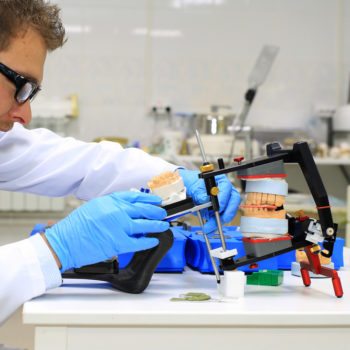Why We Love It
-
$221,390Potential Avg. Salary
-
18.3%Job Growth Rate
-
Growing DemandJob Outlook
-
Growing IndustryCareer Attribute
Pediatric and child orthodontists are dentists that specialize in straightening teeth through the installation and maintenance of braces, retainers, and other adjustment equipment. They work specifically with child and adolescent patients, installing braces and teaching patients to care for braces.
Recommended Schools
What is a Pediatric or Child Orthodontist?
The following job responsibilities are common for individuals in pediatric and child orthodontist roles:
- Evaluate new patients to recommend a treatment plan
- Measure patient mouths and teeth to create or order braces, retainers, or mouth guards
- Install braces and wires, and teach patients how to care for equipment
- Follow up with patients frequently to monitor progress, tighten braces, and make adjustments
- Manage office staff, including receptionists, technicians, and assistants
A Day in the Life
Orthodontists are dentists that specialize in straightening teeth. While general orthodontists may work with patients of any age group, pediatric orthodontists specialize in treating children and adolescents. Children are usually referred to orthodontists by a pediatric dentist when adult teeth some in crooked. When new patients arrive, orthodontists evaluate the position of teeth to recommend a plan of action for treatment, which may include installation of braces, use of a retainer, or other treatments.
If patients need to be fitted for braces, retainers, mouth guards, or night guards, the orthodontist measures the patient’s mouth and teeth. This allows the orthodontist to order appropriately sized hardware from a dental laboratory. Once the equipment arrives from the laboratory, the orthodontist works to install the equipment in the patient’s mouth. This may include adhering braces to a patient’s teeth, installing wires, or simply ensuring that retainers, mouth guards, and night guards fit correctly.
While a patient is being treated by an orthodontist, he/she visits the orthodontist frequently for evaluations and adjustments. Over the course of wearing braces, the orthodontist works to tighten braces to straighten teeth little by little without causing the patient too much pain. Once teeth are straight, the orthodontist removes the braces and polishes the patient’s teeth. He/she may also recommend continued treatment, such as wearing a retainer or mouth guard after braces are removed.
Typical Work Schedule
Pediatric orthodontists often work full-time following the regular 40-50 hours schedule. The working hours may also be shifted to start from 10 am to 6 pm or to include weekends to allow more availability to the clients outside the school time or the working hours of the families. This shows how your schedule may vary depending on the work environment as some may have a different schedule with less than 40 hours a week and some could work for considerably longer hours.
Projected Job Growth
According to the US Bureau of Labor Statistics, the demand for orthodontists is expected to grow by at least 2% from 2019 to 2029 which is less than the average for all other occupations. However, pediatric orthodontists have a slightly higher expected rate. Recently, there has been a demand for promoting good oral hygiene as recent research shows its link to overall health. In addition, children will often need more interventions to secure their future oral health. This increased demand however will also be matched with strong competition for the available opportunities as the number of graduates in this field increase. The competition is expected to be stronger in places where sufficient number of pediatric orthodontists already exist.
Typical Employers
Pediatric orthodontists have multiple employers available ranging from different medical care centers, hospitals as well as other physicians’ offices. However, some prefer to work privately whether individually or with a partner. They can establish their own offices where they can continue their practices with more flexibility. This is also more financially rewarding but it is more challenging because you need to invest your time and effort to build your network of clients and gain more trust in the field.
Recommended Schools
How To Become a Pediatric or Child Orthodontist
The starting point for becoming a pediatric or child orthodontist is earning a bachelor’s degree. The type of bachelor’s degree pursued is flexible, though most individuals have more success getting admitted into dental school if their bachelor’s degree program requires them to take several science courses. After earning a bachelor’s degree and taking the required dental school graduate program standardized test, students can apply to schools that offer professional dentistry graduate programs.
Aspiring pediatric orthodontists must then complete a professional dentistry program to become general dentists. There are three common degrees awarded to dentists: Doctor of Dental Surgery (DDS), Doctor of Dental Medicine (DDM), or Doctor of Medical Dentistry (DMD). After completing the graduate dentistry program, students are required to pass written and practical exams administered by the Joint Commission on National Dental Examinations (JCNDE) to become licensed to work as general dentists.
While graduation from dentistry school allows you to find work as a general dentist, additional education is required to specialize in child orthodontics. After graduating from dental school, you’ll need to enroll in an orthodontics residency. These residency programs last two or more years and require both coursework and practical training that’s specific to the field of orthodontics. After completing an orthodontics residency, you may also need to take additional exams to become licensed to work as a pediatric or child orthodontist in your state of practice.
Pediatric or Child Orthodontist Salary Data
We’ve provided you the following to learn more about this career. The salary and growth data on this page comes from recently published Bureau of Labor Statistics data while the recommendations and editorial content are based on our research.
National Anual Salary
Low Range
$137,150Average
$221,390High Range
---National Hourly Wage
Low Range
$66/hrAverage
$106/hrHigh Range
---How do Pediatric or Child Orthodontist salaries stack up to other jobs across the country? Based on the latest jobs data nationwide, Pediatric or Child Orthodontist's can make an average annual salary of $221,390, or $106 per hour. On the lower end, they can make $137,150 or $66 per hour, perhaps when just starting out or based on the state you live in.
Salary Rankings And Facts
#5 Nationally for All Careers
Above Average Salary Nationally
Highest Education Among Pediatric or Child Orthodontists
- 95.5% Doctorate
- 2.1% Masters
- 1.7% Bachelors
- 0.3% Associates
- 0% College
- 0.3% High School
- 0.2% Less than High School
Job Growth Projections and Forecast
2014 Total Jobs
8,2002024 Est. Jobs
9,700Job Growth Rate
18.3%Est. New Jobs
1,500How does Pediatric or Child Orthodontist job growth stack up to other jobs across the country? By 2024, there will be a change of 1,500 jobs for a total of 9,700 people employed in the career nationwide. This is a 18.3% change in growth over the next ten years, giving the career a growth rate nationwide of Above Average.
Growth Rankings And Facts
#69 Nationally for All Careers
Above Avg. Growth Nationally
What Companies Employ The Most Pediatric or Child Orthodontists
| Industry | Current Jobs | New Jobs Needed | % Increase |
|---|---|---|---|
| Offices of dentists | 5,900 | 1,100 | 1% |
| Self-employed workers | 1,900 | 300 | 0% |
| Offices of physicians | 100 | --- | --- |












